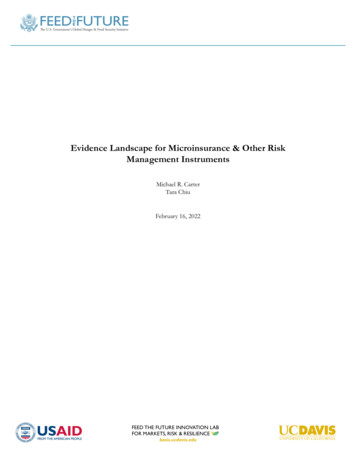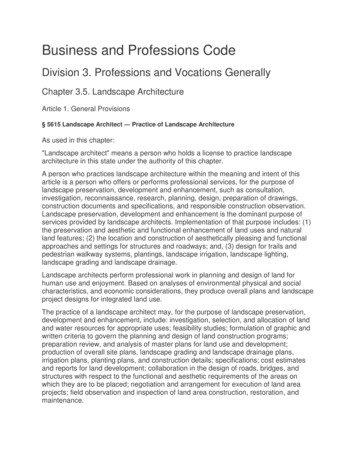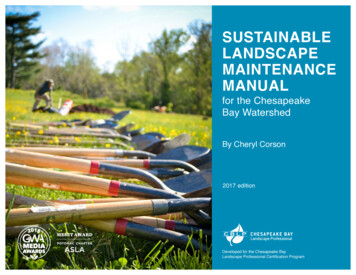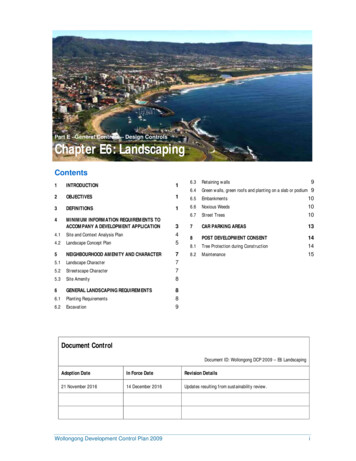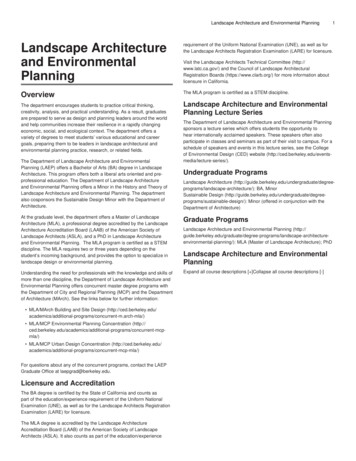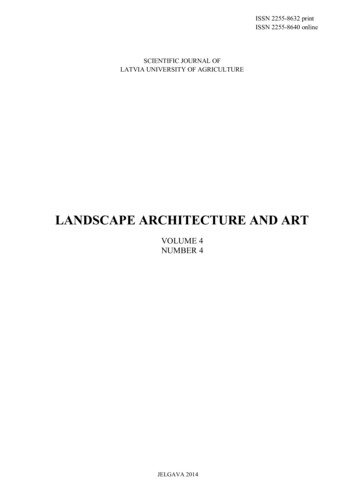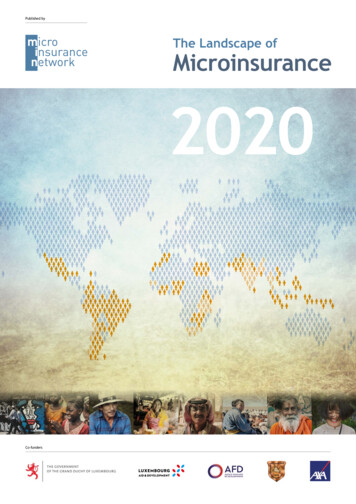
Transcription
Published byThe Landscape ofMicroinsurance2020Co-funders
Published by: Microinsurance Networkwww.microinsurancenetwork.orgLayout: www.orbital.co.ukContentsAuthor: Alice Merry, Financial Inclusion Consultant, PeruThe publication is protected by the law of the 18 April 2001 of the Grand-Duchyof Luxembourg concerning copyright databases and related laws. It is strictlyprohibited to reproduce an article from this publication, in whole or in part,without the written consent of the publisher.The quantitative information presented in this paper does not represent anabsolute number of products, clients or other data. Rather, this paper reportswhat the team was able to identify as microinsurance. Although the data for thisstudy is not an absolute measure of microinsurance in the three regions studied, thedata set is large enough to represent the “landscape” of microinsurance and provide,for the most part, an accurate picture of these markets and their components.Disclaimer: The views, opinions and theories of all outputs of the World Map of Microinsurance(WMM) programme as contained herein are solely the views, opinions and theories of the authors,and do not necessarily reflect the views, opinions and theories of the Microinsurance Network, itsmembers and/or its affiliated institutions as well as sponsors and their related entities. In addition,the country and territory names, borders, and/or scaled sizes depicted in this paper, the WMMmap images, and the online, interactive map are for illustrative purposes and do not imply theexpression of any opinion on the part of the Microinsurance Network, its members and/or itsaffiliated institutions as well as sponsors and their related entities, concerning the legal status of anycountry or territory or concerning the delimitation of frontiers or boundaries. The MicroinsuranceNetwork makes no representation as to the accuracy, completeness, or reliability of any information,views, opinions, and theories as may be contained herein. The Microinsurance Network herebydisclaims any liability in this regard.ISBN 978-2-9199658-0-9 2020 by Microinsurance Network.All rights reserved.Acknowledgements5Glossary6Abbreviations71 Executive summary92 Methodology113 Global view133.1 Market size and evolution133.2 Products183.3 Distribution213.4 Gender243.5 Claims253.6 The impact of COVID-19264 Africa294.1 Market size and evolution294.2 Products324.3. Distribution344.4 Gender364.5 Claims375 Asia395.1 Market size and evolution395.2 Products425.3 Distribution445.4 Gender465.5 Claims476 Latin America and the Caribbean496.1 Market size and evolution496.2 Products526.3 Distribution546.4 Gender556.5 Claims55Appendix A Microinsurance Landscape Questionnaire56Appendix B Insurers per country and response rates57Appendix C Response rates for each indicator and region58THE LANDSCAPE OF MICROINSURANCE 2020 3
Figures, tables & boxesAcknowledgementsList of figuresThe Microinsurance Network asbl would like to thank the sponsors of this study,namely the Luxembourg Ministry of European and Foreign Affairs, the LuxembourgMinistry of Finance, the French Development Agency, AXA Emerging Customersand the Insurance Federation of Egypt for the financial support and their othercontributions that have made this study possible.Figure 1World map of inclusive insurance regulation in 2019 from theAccess to Insurance Initiative (A2ii)Figure 2People covered in all regions by product line19Figure 3Premiums collected (USD millions) in all regions by product line19Figure 4The proportion of products in all three regions which make useof each distribution channel type21Figure 5Median claims ratios in all regions by product line25Figure 6People covered by product line in Africa33Figure 7Premiums collected (USD millions) by product line in Africa33Figure 8The proportion of products which make use of each distributionchannel type in Africa34Median claims ratios in Africa by product line37Figure 916-17Figure 10 People covered in Asia by product line43Figure 11 Premiums collected (USD millions) by product line in Asia43Figure 12 The proportion of products which make use of each distributionchannel type in Asia44Figure 13 Median claims ratios in Asia by product line47Figure 14 People covered by product line in Latin Americaand the Caribbean53Figure 15 Premiums collected (USD millions) by product linein Latin America and the Caribbean53Figure 16 The proportion of products which make use of each distributionchannel type in Latin America and the Caribbean54Figure 17 Median claims ratios in Latin America and the Caribbeanby product line55List of tablesTable 1Focus countries for this year’s Landscape study11Table 2Estimated proportion of the population and market capturedin the countries studied in each region14The median percentage of female clients in each region24Table 4Data on claims in each region25Table C1Number and proportion of products reported by product line58Table C2Number and proportion of products for which usable datawas provided for each indicator58Table 3A special thank you goes to all the insurers and aggregators who dedicated their time and efforts to providing the dataessential to this study.We recognise the dedicated contributions of our country researchers, particularly under the challenges created by havingto carry out the primary research between March and July 2020, with most countries in some degree of lockdown due to theglobal pandemic: Aisha Bashir (Nigeria); Pierre Bonzom (Morocco); Joseph Chikonde (Zambia); Guillaume Dugu (Rwanda);Ana Hernandez (Argentina, Bolivia, Chile, Colombia, Mexico, Peru); Nguyen Hong Huong (Vietnam); James Irungu Kimani (Kenya);Prashansa Jain (Philippines); Saheem Khizar (Pakistan); Thanuja Krishnaratna (Sri Lanka); Kingsley Kwabahson (Ghana);Jemma Maclear (Cambodia and South Africa); Atanu Majumdar (India); Reinhard Marcellino (Indonesia); Prechhya Mathema(Nepal); Justina Moonga (Tanzania); David Mureriwa (Zimbabwe); Porntida Poontirakul (Thailand); Katharine Pulvermacher(Jamaica); Sisili Rahman (Bangladesh); Alex Sea (Cote d’Ivoire); Yasmine Badr (Egypt); Ibrahima Sy (Senegal);Bento Zanzini (Brazil).We further thank the experts interviewed for providing their perspectives on the development of microinsurance markets,including Hannah Grant (Access to Insurance Initiative); Dominik Wehgartner (Allianz); Quentin Gisserot and Laura Rosado(AXA); Mathilda Ström (BIMA); Jeremy Gray and Christine Hougaard (Cenfri); Pedro Henrique Fernandes Pinheiro (CNseg);Thomas Wiechers and Kelvin Massingham (Financial Sector Deepening Africa); Gregor Sahler (GIZ); Mark Robertson andDeanne Van Doesburgh (Hollard); Pranav Prashad (ILO’s Impact Insurance Facility); Roshaneh Zafar (Kashf Foundation);Alejandra Díaz Agudelo (MiCRO); Richard Leftley (Micro Insurance Company); Queenie Chow and Mariah Mateo Sarpong(MicroInsurance Centre at Milliman); Syed Mohsin Ahmed (Pakistan Microfinance Network); Lorenzo Chan (Pioneer);Gilles Renouil (Women’s World Banking); Craig Thorburn (World Bank).Finally, we thank the members of the Microinsurance Network Landscape Best Practice Group for their contributions andfeedback throughout this study: A2ii; ADA; AM Best; AXA Emerging Customers; BRS; Cenfri; CNseg; Denis Garand & Associates;Fasecolda; Fundación PROFIN; GIZ on behalf of BMZ; Guardian Life; IFAD; ILO’s Impact Insurance Facility; InsuResilienceGlobal Partnership; MiCRO; MicroInsurance Centre at Milliman; Microinsurance Master; Milliman; Munich Re Foundation; TheCenter for Insurance and Risk Management (also known as The Katie School of Insurance and Risk Management) at IllinoisState University; The Center for the Economic Analysis of Risk (CEAR) at Georgia State University; Women’s World Banking.Within this group, particular appreciation goes to our reviewers: Marieme Ba; Hui Lin Chiew; Denis Garand; QuentinGuisserot; Mariah Mateo Sarpong; Michael J. McCord; Steve Mitchell; Bert Opdebeeck; Teresa Pelanda; Dirk Reinhard; GregorSahler; Kay Tuschen.List of boxesBox 1Country profilesBox 2Working definition of microinsurance108Box 3People covered18Box 4Developing index insurance in West Africa31Box 5The Indian microinsurance market40Box 6The potential for microinsurance growth in Jamaica504 THE LANDSCAPE OF MICROINSURANCE 2020THE LANDSCAPE OF MICROINSURANCE 2020 5
GlossaryAccident insuranceInsurance that covers an event thatis unforeseen, unexpected, andunintended.Claims valueThe total amount of money paid outby the insurer for accepted claimssubmitted by the insured.ActuaryA technical expert in insurance andapplied mathematics, who appliestheories of probability, economics, andfinance to the business of insuranceand is responsible for the calculationof premiums, reserves, and othervaluations.CoverageThe scope of protection provided undera contract of insurance, and any ofseveral risks covered by a policy.AgentAn insurance company representativewho solicits, negotiates or effectsinsurance contracts, and providesservice to the policyholder for theinsurer, usually for a commission onthe premium payments.BrokerAn intermediary between insurersand distribution channels, a broker’sfunctions can range from those ofan agent, to designing products andpre-processing claims. Unlike an agent,the broker is licensed in some countriesto deal with several insurers and ispermitted to take on all or a portionof the administration.Cell captiveAn insurance or reinsurance captivewhich is sponsored and operated by oneentity, usually an insurance company,but can be used by another entity.ClaimFollowing a loss due to occurrence ofan insured event, a claim is a requestfor compensation by an insured partyor beneficiary.Claim turnaround timeAverage days from the submissionof an insurance claim to paymentof that claim.Claims ratioThe claims ratio is calculated asclaims paid as a percentage of thewritten premium.Credit life insuranceCredit life is insurance coveragedesigned to extinguish the outstandingindebtedness of a borrower that dieswhile indebted.Crop insuranceAn insurance product which insuresfarmers against the loss of their cropdue to natural events such as drought,flooding, hail etc.Digital platformA virtual space that allows for directinteractions between consumersand providers of goods and services.Such platforms include ride hailingplatforms, delivery platforms,e-commerce and freelancer platforms,among others.Group insuranceGroup insurance is a policy offered topeople belonging to a certain group,such as employees of a company ormembers of an organisation. Usually,the coverage ceases once the insuredis no longer a member of the group.Health insuranceCoverage that provides benefits as aresult of sickness or injury. Policiesmay include insurance for losses fromaccidents, medical expenses, disability,or accidental death and dismemberment.Hospital cash insuranceHealth insurance that provides astipulated daily, weekly, or monthlypayment to an insured person duringhospital confinement, without regardto the actual confinement expense.Individual insuranceA policy purchased directly by theinsured person, as distinct fromgroup insurance.InsurtechThe use of technology innovationsin the insurance industry.Distribution channelA person or company that aids theinsurer in distributing the product.Also referred to as an intermediary.Legal insuranceAn insurance product designed to coverlegal advice and legal expenses undercertain circumstances.Expense ratioThe expense ratio is calculated asadministrative costs as a percentageof the written premium.Life insuranceCoverage providing for payment ofa specified amount on the insured’sdeath, either to the deceased’s estateor to a designated beneficiary.Funeral insuranceFuneral insurance is an insuranceproduct designed to cover the costs ofthe insured’s funeral on their death.FreemiumA pricing strategy by which a productor service is provided free andcustomers are given the option topurchase additional features orservices (or to extend their cover,in the case of insurance).Livestock insuranceA product covering losses as a resultof the death of livestock.Low-income populationFor the purposes of this study, lowincome refers to individuals earningbetween two and 20 internationaldollars per day on a purchasing powerparity basis. This was calculated foreach country covered in the study usingWorld Bank data (World DevelopmentIndicators).Mandatory insuranceInsurance that one is required topurchase, either because of governmentmandate (for example, third-partyliability auto insurance) or as acondition for accessing another service(for example, credit life insurance thatis required when one takes a loan).Mandatory cover can control adverseselection and significantly reduceadministrative costs.MicroinsuranceMicroinsurance products havemodest premium levels based onthe risks insured. They are developedspecifically to serve the low-incomepopulation. The insurer is the riskcarrier, and the product must beworking towards profitability, or atleast sustainability, and managed onthe basis of insurance principles. Forthe purposes of this study, the termmicroinsurance covers all productsthat fit within this definition, and maytherefore include products that arenot considered as microinsurance by anational insurance supervisor, becausesuch definitions vary from one countryto another.People coveredThe number of people covered includesthe policyholder as well as othersinsured under the policy. For example,a life or health insurance policy maycover family members. In the case oflivestock and crop insurance, peoplecovered refers to the number offarmers or livestock owners who havetaken out the insurance.PolicyThe specific contractual agreementunderlying the terms between theinsurer and the insured.Travel insuranceAn insurance product designed to coverthe costs and losses associated withunexpected events while travelling,such as medical expenses, tripcancellation or lost luggage.PremiumOne or more payments required toactivate insurance coverage and keepit in force.Turn-around timeThe number of days between an insuredincident occurring and the pay-outbeing received by the beneficiary.Premiums collectedThe total amount of money collectedfrom the policyholders by the insurer.Value-added servicesAdditional services or benefitswhich customers receive whenbuying a product.Property insuranceInsurance providing financial protectionagainst the loss of, or damage to,real and personal property caused bysuch perils as fire, theft, windstorm,hail, vandalism, etc.Voluntary coverAllows consumers to choose theamount, term and type of insurancethat they want; in contrast tomandatory insurance.Abbreviationsa2iiAccess to Insurance InitiativeATIAssociation of Tanzanian InsurersBOADBanque Ouest Africaine deDéveloppement(West African Development Bank)CNAASCompagnie Nationale d’AssuranceAgricole du Sénégal(National Agriculture InsuranceCompany of Senegal)GIIFGlobal Index Insurance FacilityMFIMicrofinance institutionMNOMobile network operator6 THE LANDSCAPE OF MICROINSURANCE 2020Regulation of insuranceGovernment-defined requirements foran insurer, such as minimum capitalrequirements and necessary expertise;also provides consumer protectionthrough insurer oversight, includingpricing policies, form design andappropriate sales practices.MBAMutual benefit associationPMFBYPradhan Mantri Fasal Bima Yojana(Prime Minister’s CropInsurance Scheme)SMESmall or medium-sized enterpriseWMMWorld Map of MicroinsuranceTHE LANDSCAPE OF MICROINSURANCE 2020 7
1. Executive SummaryA total of 194 insurance providers in27 countries in Africa, Asia and LatinAmerica and the Caribbean participatedin this study.1 Whereas previouslandscape studies have attempted tocover all countries in a region, we havenow adopted a methodology whichfocuses on selected countries acrossthree regions.BOX 1Country profilesThis study is accompanied bycountry profiles providing contextualinformation as well as themicroinsurance data obtainedat country level. The countryprofiles are available upon requestfrom the Microinsurance Network.Across these 27 countries, 194 insurerscovered between 41 and 102 millionpeople through microinsurance productsin 2019, representing between 3% and7% of the low- and middle-incomepopulation of those countries. A totalof USD 1,060 million was collected inmicroinsurance premiums, representingabout 5% of the estimated potentialmarket for microinsurance in thecountries concerned.2These numbers do not include datafrom India, which was severely affectedby the lockdown and was not able toprovide data in time for this report.Including publicly available data fromIndia, as well as publicly available datafrom Allianz in countries where it wasnot provided locally, between 162 and253 million people were covered across28 countries. This figure representsbetween 6% and 10% of the low- andmiddle-income population in thesecountries.Across all three regions, life and creditlife products continue to dominatemicroinsurance markets, with personalaccident and funeral products alsoplaying an important role. In Africaand Asia, low-cost health products,particularly hospital cash products,have consolidated over recent years tobecome another key microinsuranceoffering.8 THE LANDSCAPE OF MICROINSURANCE 2020Additionally, in all three regions,insurers are strengthening their linkswith health services, including bundlingtheir products with telehealth services.Crop and livestock insurancehave experienced mixed results.Where there is government supportand subsidies, schemes have growndramatically, but without such supportthey have struggled to achieve scale.Despite positive developments inmicroinsurance markets in all regions,there are important concerns aroundthe value provided to customers. Claimsratios across the three regions arerelatively low, at a median rate of 23%.Most worryingly, a third of productsin all regions, and half of products inLatin America and the Caribbean, haveclaims ratios in single digits.Agents, brokers, financial institutions andmicrofinance institutions (MFIs) remainvery important in microinsurancedistribution. The high use of agents(whether the insurer’s own sales forceor linked to a distribution partner) inover half of products stresses thecontinued need for human contactin order to sell microinsurance andeducate customers. Increasingly,insurers that attempted highlydigital approaches are reintroducingelements of human touch and creatinghybrid models.Finally, although this study is basedon data from 2019, it is clear that thetrends explored in this report will beimpacted by the COVID-19 pandemic.Although the full effects are not yetknown, early indications suggest thatthe pandemic is accelerating digitisationand increasing customer awareness ofrisk, while also leaving some customerswith unmet expectations and manyinsurers and distributors hard hit bythe crisis.The Landscape of Microinsurance inAfrica 2018 explored the rise and fallof MNO-linked freemium models inAfrica. In many cases, MNOs havedropped insurance, but some partnershipshave continued and shifted to paidproducts. These paid products requirea more active sales approach, whichoften includes call centres and agents.They have not reached the samescale seen in freemium models butmay well provide a more sustainablecustomer base.At the same time, mobile money anddigital platforms, including ride-hailingand delivery platforms, have surgedglobally. Successful cases of leveragingsuch platforms for microinsuranceare emerging.1An analysis of the total number of insurers and targeted insurers as well as response rates can be found in Appendix B.2See explanations of these calculations in the following Methodology section.THE LANDSCAPE OF MICROINSURANCE 2020 9
2. MethodologyThe Landscape of Microinsurance 2020 presents information on microinsurancemarkets in three regions: Africa, Asia and Latin America and the Caribbean.Whereas landscape studies before 2018 attempted to cover all countries in aregion, we have now adopted a methodology which focuses on selected countriesacross three regions, with annual follow-up to support market development.BOX 2Working definition ofmicroinsuranceMicroinsurance products havemodest premiums based on therisks insured. They are developedspecifically to serve the low-incomepopulation. The insurer is the riskcarrier, and the product must beworking towards profitability, or atleast sustainability, and managedon the basis of insurance principles.In each region, focus countries werechosen (table 1), and efforts weremade to collect primary data on themicroinsurance products availablein each country. In addition, widerinformation on the market contextwas collected and included in thecountry profiles, available from theMicroinsurance Network.In some cases, despite the team’sbest efforts, it proved impossible toobtain responses from a representativenumber of insurers. The Chileaninsurance sector indicated thatmicroinsurance does not exist in thecountry. India was severely affected bythe lockdown and it is hoped that the2019 data will become available inthe near future.In South Africa, only limited data hadbeen provided at the time of preparingthis report, a situation that one hopeswill change with the support of theSouth African Financial Sector ConductAuthority. Work carried out by theAssociation of Tanzanian Insurers (ATI)will likely be incorporated into thedata available on the World Map ofMicroinsurance at a later stage.Between all the countries outlinedbelow, 194 insurers provided selfreported data on the performance oftheir microinsurance products as at31 December 2019. Insurers were givenquestionnaires and asked to providedata for each microinsurance productthey offer. Collaborators based inTABLE 1FOCUS COUNTRIES FOR THIS YEAR’S LANDSCAPE STUDYAFRICAASIALATIN AMERICA &THE CARIBBEANCôte exicoSenegal*Sri LankaPeruSouth Africa***Thailand*Tanzania***Vietnameach country or region engaged withinsurers to encourage and support theirparticipation.Extensive efforts were made to secureresponses, but it is certain that thedata in this study does not capturethe microinsurance markets in thesecountries in their entirety. Therefore,the study should be understoodprincipally as analysis of the datacommunicated by the insurers whoparticipated from the countriesselected in each region. Furtherinformation and the inclusion ofadditional insurance providers andcountries could alter the picturepresented for each region.The data collected is limited toproducts provided by formal insuranceproviders – insurance companies andother providers governed by theinsurance regulator. In some countries,further microinsurance may be providedsemi-formally or informally by otherproviders like funeral parlours. Theseproducts are not included in thisstudy due to the additional difficultiesinvolved in collecting data from theseorganisations.In addition, in order to validatethe trends observed in the dataand provide context and furtherinformation, interviews were carriedout with experts from 18 organisationsacross Africa, Asia and Latin Americaand the Caribbean. This qualitativeinformation allows us to share abroader picture of developments andemerging trends in microinsurancemarkets in each region.ZambiaZimbabweNotes to Table 1: * Countries for which no data was submitted; ** Countries for which data is still expected,but will be provided too late for inclusion in this report; *** Countries for which very limited data was submitted andincluded in the analysis presented in this paper, and for which further data is expected.10 THE LANDSCAPE OF MICROINSURANCE 2020THE LANDSCAPE OF MICROINSURANCE 2020 11
3. Global View3.1Market size and evolutionAcross the 194 insurance providers who participated in the study, between 41and 102 million people were recorded as covered by a microinsurance product.This figure is calculated based on insurance providers’ reporting on the numberof people covered by each of their products.Given that one client may have morethan one insurance product, the totalnumber of people covered is presentedas a range. The lower number is basedon the total number of people coveredby the largest product line and thehigher number is based on the totalpeople covered by all products.This range represents between 3%and 7% of the low- and middle-incomepopulation of the countries studied,3excluding Zimbabwe and Jamaicawhere recent, reliable information onthe size of the low- and middle-incomepopulation was not available. Thecorresponding figures for each regionare given in Table 2.These numbers do not include data fromIndia, which was severely affectedby the lockdown and was not able toprovide data in time for this report.Including publicly available data fromIndia,4 as well as publicly availabledata from Allianz5 in countries whereit was not provided locally, between312 THE LANDSCAPE OF MICROINSURANCE 2020162 and 253 million people werecovered across 28 countries worldwide.This figure represents between 6% and10% of the low- and middle-incomepopulation in these countries(excluding Zimbabwe and Jamaica).A total of USD 1,060 million wascollected in microinsurance premiumsacross the 27 countries in whichinsurers participated in the study. Thepotential value of the microinsurancemarket in these countries is estimatedat USD 20,500 million (again, excludingZimbabwe and Jamaica), based on theentire low- and middle-income populationbeing covered by one insurance product.6In these countries, current microinsurancepremiums represent about 5% of thatpotential market.These figures vary across the threeregions studied, with the largestproportion of the estimated marketvalue captured in Latin America andthe Caribbean (Table 2).Figures for low- and middle-income populations are calculated based on population data from the United Nations World Population Prospects 2019 and percentages of the populationclassified as low- and middle-income by Pew Research Center.4Insurance Regulatory and Development Authority of India (2019). Annual Report 2018-2019; and Pradhan Mantri Fasal Bima Yojana (2020). Crop insurance dashboard5Allianz (2020). Emerging Consumers: 2019 Full Year Report6This value is based on the median premium per person covered calculated for each region in this study (USD 14 in Africa, USD 8.80 in Asia, and USD 18.92 in Latin America).THE LANDSCAPE OF MICROINSURANCE 2020 13
RegulationTABLE 2ESTIMATED PROPORTION OF THE POPULATION AND MARKET CAPTURED IN THECOUNTRIES STUDIED IN EACH REGIONREGIONMinimum proportion of thelow- and middle-incomepopulation covered byrespondentsMaximum proportion of thelow- and middle-incomepopulation covered byrespondentsProportion of theestimated microinsurancemarket value capturedby respondentsAfrica2%6%4%Asia4%7%3%Latin America andthe Caribbean2%5%9%All regions3%7%5%Players in themicroinsurance marketMicroinsurance has moved up theagenda among insurance companiesglobally and there are now enoughsuccess stories to convince the vastmajority that microinsurance can besuccessful, at least for certain producttypes and distribution arrangements.Nonetheless, many insurers face internalcapacity constraints and restrictedinvestment available for innovation dueto limited incomes. As a result, despitesome stand-out innovations, manyinsurers are offering the same kindsof microinsurance products that haveexisted in the market for a long time.These are often not based on a deepunderstanding of customers, andcontinue to contain features likeinappropriate exclusions, despitelong-standing findings on these topics.7Interviews conducted for this studysuggest that the insurers that areinnovating are those with the financialflexibility to experiment. In manycases, this has proved very difficult fornational insurers. International insurershave the required financial capacitybut can be held back by the need tosecure regional or head-office approval,as well as to work with systems andrules usually designed withindustrialised countries in mind.They are also more likely to pull outof countries more quickly.In some cases, and particularly in Africa,it is regional insurers that have thenecessary financial capacity, flexibilityand close contact with markets to besuccessful in innovating and securingnew partnerships. Given their presencein several countries, they also havethe capacity to replicate successfulinnovations across groups of similarmarkets, bringing a greater return ontheir investment in innovation.Cenfri (2019) Insurtech tracker: The rise of insurtechs in emerging markets14 THE LANDSCAPE OF MICROINSURANCE 2020Non-insurance actors are also taking alarger role in driving the market. A largenumber of insurtech companies haveentered the microinsurance market inthe last five years. Cenfri’s insurtechtracker7 has identified 481 insurtechinitiatives launched by 292 insurtechsin emerging markets across Africa,Asia and Latin America since 2000.Half of these initiatives were launchedbetween 2015 and 2019. Meanwhile,some MFIs have developed designatedinsurance departments or even createdtheir own brokers. And some technologyservice companies and distributors arelooking to become insurers.Regulation has seen significantdevelopments across all three regionsin recent years (Figure 1). Althoughregulation challenges persist, mostexperts interviewed felt that regulationhad become less of a constraint in mostcountries, with regulators often seenas widely supportive of microinsurance.In some countries, regulators havetaken on an explicit insurance marketdevelopment mandate and activelyencourage innovation. This mandaterepresents an important shift in theirapproach, enabling them to be moreproactive and develop new tools toreach out to insurers and insurtechsand promote innovation.Various frameworks and tools haveemerged over time. These includeregulatory sandboxes, which wereoriginally
Acknowledgements5 Glossary 6 Abbreviations7 1 Executive summary 9 2 Methodology 11 3 Global view 13 3.1 Market size and evolution 13 3.2 Products 18


